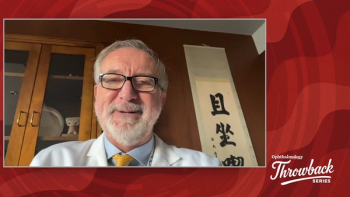
Adopting pars plana anterior vitrectomy
According to Michael E. Snyder, MD, the pars plana anterior vitrectomy offers more advantages than disadvantages and can be readily adopted by anterior segment surgeons.
Reviewed by Michael E. Snyder, MD
The pars plana anterior vitrectomy offers more advantages than disadvantages and can be readily adopted by anterior segment surgeons, according to Michael E. Snyder, MD, a professor of ophthalmology at the University of Cincinnati in Ohio.
“There are several advantages to the pars plana approach,” Snyder said during the 53rd Sally Letson Symposium, adding that this approach offers superior visualization. “There is a limited view from a vitrector deforming the limbal wound, [whereas] a pars plana incision maintains normal corneal optics.
“First, we are maintaining a pressurized globe,” Snyder said. “We have a contained system. If we have a contained system, there is less risk of hemorrhage, less traction on the vitreous, and maintenance of normal anatomic relationships.”
One of the reasons for not performing a limbal vitrectomy is that when working at the limbus, the pressure gradients bring vitreous forward, Snyder explained. “Pulling the gel forward is not what we want to do,” he said. “It also provides very poor access to subincisional vitreous and a greater likelihood of damaging residual capsular support, if there is some remaining.”
Moreover, by going through the limbus, the vitrector will not seal through a limbal incision, and the lowest pressure point in the system is at the wound, according to Snyder.
“For anterior segment surgeons, our goal is to get the vitreous out of the anterior segment without causing any damage to residual structures in the front or back,” Snyder said. “We want an anterior-to-posterior gradient, and if we have an anterior fusion and our vitrector port is going through the pars plana, we have created that favorable anterior-to-posterior gradient.”
Snyder added that it is important for surgeons to remember the bottle height to maintain globe tension, keeping in mind the flow limitations of the system. “I put the bottle height at the maximum,” he said.
When it comes to hydration of the vitreous, there should not be major concerns. “The vitreous is already 99% water, and it lives in an aqueous environment,” he said. “You cannot hydrate something that is already made of water and lives in an aqueous environment. The most important parts of the vitreous are the remaining 1%. It’s the collagen fibrils within the hyaluronan matrix. The collagen fibrils are attached most firmly at the optic nerve, macula, and peripheral retina near the vitreous base. Those are the key things to remember.”
In terms of instrumentation, anterior irrigation can be achieved with a 21-gauge butterfly needle or either a hand-held or self-retaining anterior chamber maintainer through a paracentesis, creating that favorable anterior-to-posterior pressure gradient, Snyder explained. The vitreous is not truly invisible, and there are steps ophthalmologists can take to improve the view of it, such as staining the vitreous with triamcinolone, according to Snyder.
Some may voice concerns about safety with the pars plana anterior vitrectomy, but Snyder pointed to his own clinical experience, which has been published.1 Snyder identified more than 300 eyes treated by pars plana approach to anterior vitrectomy from September 2010 to June 2016. Most of these were planned at the time of an anterior segment reconstruction. In that retrospective case series, the mean postoperative follow-up was 10.9 months and the mean patient age was 62.4 years. There were 3 eyes (0.9%) with retinal detachments and 1 eye (0.3%) with a retinal tear without detachment. There were no cases of endophthalmitis and no evidence of residual vitreous prolapse in the anterior chamber in any eye postoperatively.
Snyder and colleagues noted the safety and efficacy of the pars plana technique compared favorably with historical data for coaxial and bimanual limbal clear corneal infusion and cutting, and they concluded that sutureless pars plana anterior vitrectomy should be considered a safe and reliable solution for the anterior segment surgeon in managing vitreous prolapse during anterior segment surgeries.
“All these patients were treated successfully,” he said.
In terms of learning the procedure, there are steps anterior segment surgeons can take to learn how to perform a pars plana anterior vitrectomy. Indeed, an anterior segment surgeon can ask to scrub in with a vitreoretinal colleague to observe how the procedure is done. There are also anterior vitrectomy training models. For example, SimulEYE is a model that fills the eye with a realistic synthetic vitreous, which allows visualization of the gel.
The surgeon can learn when to use the cutter and when to use the aspiration setting, and they can see the effects visually in the artificial gel. Because these models have no organic material in them, they can be used with regular instrumentation, unlike cadaveric human or porcine globes.
“It is a very good model to practice with,” Snyder said.
Clinicians should not be hesitant to adopt pars plana anterior vitrectomy, according to Snyder. “Habit is never a good reason to defer change,” Snyder said. “Techniques are easy to learn for this approach, and the safety has been well documented in the peer-reviewed literature. When it comes to adopting new surgical skills, there is no better time than today.”
Michael E. Snyder, MD
P: 513-597-0074
Snyder has no financial disclosures related to this content.
Reference
1. Thornton IL, McMains BK, Snyder ME. Long-term safety and efficacy of single-port pars plana anterior vitrectomy with limbal infusion during anterior segment surgery. J Cataract Refract Surg. 2018;44(7):878-883. doi:10.1016/j.jcrs.2018.05.004
Newsletter
Don’t miss out—get Ophthalmology Times updates on the latest clinical advancements and expert interviews, straight to your inbox.



















































.png)


